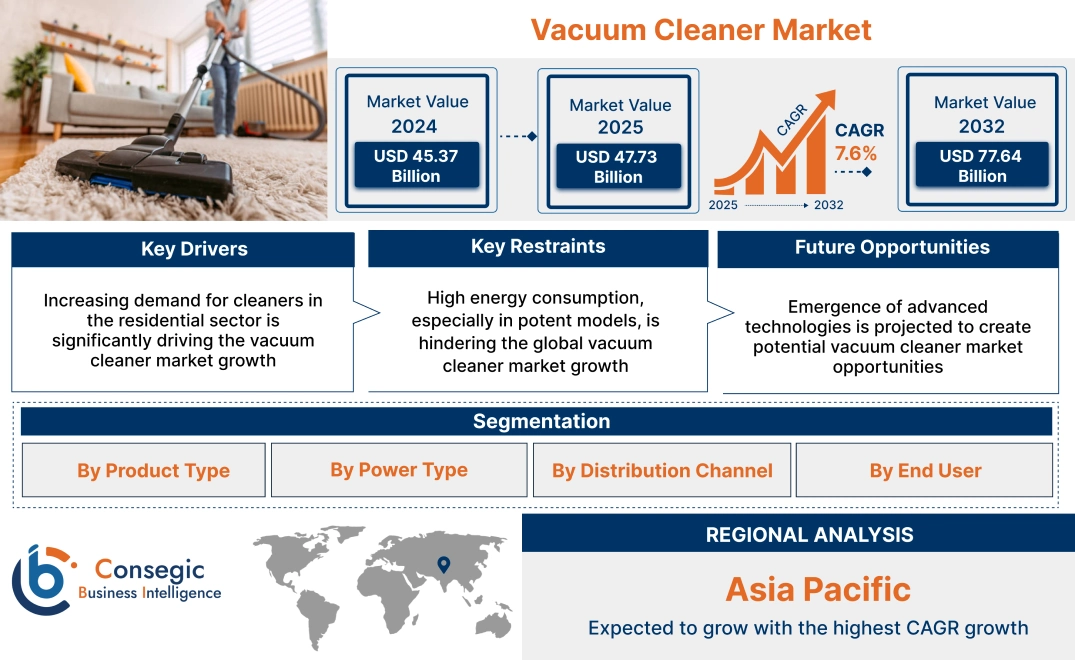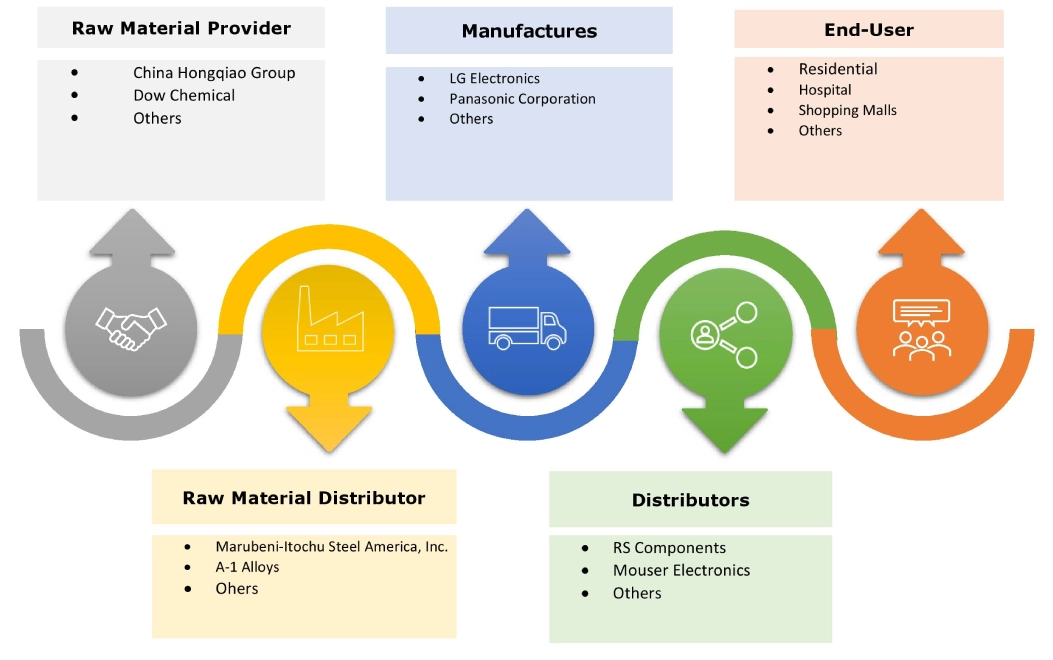Vacuum Cleaner Market Scope & Overview:
A vacuum cleaner, also called vacuum, is an electric cleaning device that creates suction to remove dirt, dust, and other debris from floors, carpets, upholstery, and other surfaces. The debris is collected in a bag or container for disposal. Vacuum cleaners come in various types, including upright, canister, stick, and handheld models, each designed for different cleaning needs and preferences.
Vacuum Cleaner Market Size:
Vacuum Cleaner Market Size is estimated to reach over USD 77.64 Billion by 2032 from a value of USD 45.37 Billion in 2024 and is projected to grow by USD 47.73 Billion in 2025, growing at a CAGR of 7.6% from 2025 to 2032.
How is AI Transforming the Vacuum Cleaner Market?
AI algorithms allow vacuums to learn users home's layout, identify different floor types, and detect dirt levels, adapting their cleaning strategies for optimal performance. Also, vacuums are integrating into larger smart home ecosystems, enhancing overall automation, and creating a more connected and seamless home cleaning environment. Further, AI and automation are driving the shift from traditional cleaning methods to sophisticated, autonomous vacuuming solutions. Hence, AI integration leads to smarter, more effective, and personalized cleaning experiences, shifting the market from manual to intelligent and automated solutions.
Key Drivers:
Increasing demand for cleaners in the residential sector is significantly driving the vacuum cleaner market growth
A primary driver for the growth of vacuum cleaners market is the rising awareness of hygiene and cleanliness, with consumers prioritizing healthy living spaces. Vacuum cleaners effectively remove dust, allergens, and pet hair, creating a healthier home environment.
Additionally, these cleaners also offer convenience and timesaving, as modern lifestyles demand quick and efficient cleaning solutions. Furthermore, technological advancements like automatic dust collection station and advanced filtration systems enhance user experience and cater to specific needs, further fueling vacuum cleaner market size.
- For instance, in March 2024, Midea launched P8 Plus, featuring a unique docking station. Unlike other cordless vacuums, the P8 Plus automatically empties its dust container into the docking station, preventing dust from escaping back into the room during emptying.
- The station uses a large 3L dust bag, minimizing the frequency of bag changes, and also serves as a charging base for the vacuum. This innovative design aims to reduce the time spent on vacuum maintenance, allowing users to focus on other activities.
Thus, as per the vacuum cleaner market analysis, the growing adoption of cleaners in residential sector owing to time-saving capabilities is driving the vacuum cleaner market share.
Key Restraints:
High energy consumption, especially in potent models, is hindering the global vacuum cleaner market growth
The elevated operating costs associated with high-wattage vacuum cleaners, primarily due to increased electricity consumption and subsequent higher energy bills, pose a significant deterrent for price-sensitive consumers. Moreover, the larger carbon footprint resulting from this increased energy usage negatively impacts demand among environmentally conscious customer segments.
Further, stringent regulatory landscapes focused on energy efficiency are driving stricter mandates for appliance power consumption, potentially restricting the availability and market penetration of these high-performance models.
Thus, as per the market analysis, high-energy consumption is impeding the vacuum cleaner market share.
Future Opportunities :
Emergence of advanced technologies is projected to create potential vacuum cleaner market opportunities
Advanced technologies including TwinAI Dodge obstacle avoidance allow vacuum cleaners to intelligently navigate around obstacles, furniture, and even pet waste, ensuring thorough cleaning without human intervention. Additionally, real-time adjusted cleaning strategy analyzes the environment and dirt levels in real-time, the vacuum cleaner can optimize its cleaning path and suction power for maximum efficiency.
This leads to faster and more effective cleaning, saving time and energy. Moreover, AI-adaptive hot water mop washing and drying takes cleaning to the next level by not only vacuuming but also mopping with hot water to remove stubborn stains and sanitize floors. The AI adapts the washing and drying process based on the floor type and dirt level, ensuring optimal cleaning without damaging surfaces.
- For instance, in September 2024, Narwal launched the Freo Z Ultra, an AI-powered robot vacuum featuring TwinAI Dodge Obstacle Avoidance. Using dual 1200p RGB cameras and AI chips, it detects over 120 household objects and navigates around obstacles with millimeter-level precision, even avoiding pet feces.
- The Freo Z Ultra employs a Real-Time Adjusted Cleaning Strategy, differentiating between dry and wet messes, and adjusting its cleaning mode accordingly. Its AI-Adaptive Hot Water Mop Washing and Drying system uses AI DirtSense to automatically adjust washing and drying temperatures based on the type of dirt detected, ensuring hygienic mop cleaning.
Hence, based on the analysis, growing adoption of advanced technologies presents significant vacuum cleaner market opportunities.
Top Key Players and Market Share Insights:
The market is highly competitive with major players providing vacuum cleaners to the national and international markets. key players are adopting several strategies in research and development (R&D), product innovation, and end-user launches to hold a strong position in the market. Key players in the vacuum cleaner industry include-
- LG Electronics (South Korea)
- Panasonic Corporation (Japan)
- Robert Bosch (UK)
- Oreck Corporation (USA)
- Dyson Ltd (Singapore)
- Techtronic Floor Care Technology Limited (USA)
- Emerson Electric Co. (USA)
- Kent (India)
- ECOVACS (UK)
- Haier Group Corporation (China)
Vacuum Cleaner Market Segmental Analysis :
By Product Type:
Based on the product type, the market is segmented into robotic, upright, canister, central, drum, wet & dry, and others.
Trends in the Product Type:
- Upright vacuums are becoming more portable and convenient with cordless options and lighter designs which in turn drive the vacuum cleaner market.
- Wet & dry vacuums are becoming increasingly popular due to their versatility in handling both dry dirt and liquid spills
Canister accounted for the largest revenue share in the year 2024.
- Increasing trend in the development of compact and lightweight canister vacuum cleaner for easier storage and maneuverability is driving the vacuum cleaner market.
- Further, canister vacuums often come with a variety of attachments for different cleaning tasks, such as upholstery cleaning, crevice cleaning, and hard floor cleaning.
- Furthermore, noise reduction is a key focus as manufacturers are developing quieter motors and airflow systems.
- For instance, Electrolux offers UltimateHome 700 canister vacuum cleaner which is designed for powerful and versatile cleaning. The cleaner boasts strong suction power and effectively cleans various floor types, from hard floors to carpets.
- Thus, features including compactness, lightweight, and versatility among others are driving the canister market.
Robotic is anticipated to register the fastest CAGR during the forecast period.
- Robotic vacuums are becoming smarter with integration of advanced navigation systems, object recognition, and the ability to learn and adapt to their environment.
- Further, self-emptying dustbins feature is becoming more common, reducing the frequency of manual emptying in turn driving the vacuum cleaner market demand.
- For instance, Dyson offers Dyson 360 Vis Nav which is designed to automatically adjust its suction power based on the floor type. A key feature is its 360-degree vision system, which uses a camera and sensors to map home and understand its surroundings.
- Therefore, integration of advanced navigation systems and object recognition technology is anticipated to boost the advancement of the market during the forecast period.
By Power Type:
Based on the power type, the market is segmented into corded and cordless.
Trends in the Power Type:
- Corded vacuums are often preferred for heavy-duty cleaning tasks and large spaces, while cordless vacuums are ideal for quick cleanups and smaller homes.
- Growing adoption of smart vacuum cleaners in residential sector is driving the market.
Corded accounted for the largest revenue share in the year 2024.
- Corded vacuums generally offer consistent and powerful suction compared to cordless models which drive the market.
- Further, corded vacuums are typically more affordable than comparable cordless models.
- Furthermore, some corded vacuums are designed for specific tasks, such as deep cleaning carpets, removing pet hair, or handling large volumes of debris mandate in vacuum cleaner market.
- For instance, Dyson offer corded vacuum cleaner such as Dyson Big Ball vacuum which features a 22ft cord for easy operation eliminating the dependency of charging the battery.
- Thus, affordability, consistent & powerful suction, and specialized features are driving the vacuum cleaner market.
Cordless is anticipated to register the fastest CAGR during the forecast period.
- Advancements in lithium-ion battery technology are driving significant expansion in the cordless vacuum market.
- Further, cordless vacuums offer freedom and maneuverability, making them ideal for quick cleanups and reaching tight spaces in turn driving the progression of vacuum cleaner market.
- Furthermore, many cordless vacuums are equipped with smart features, such as app connectivity, digital displays, and sensor-based cleaning modes.
- For instance, In June 2023, Dyson launched Gen5detect and Gen5outsize, both offering cordless features and provide powerful suction. Additionally, the machine is embedded with HEPA filtration system for collecting dirt and debris efficiently.
- Therefore, advancements in battery technology and maneuverability are driving the growth of the vacuum cleaner market size during the forecast period.
By Distribution Channel:
Based on the distribution channel, the market is bifurcated into offline and online.
Trends in the Distribution Channel:
- Consumers prefer in-store demonstrations of products which drive the need for offline sales channels which in turn propel the market.
- The hassle free return policy and convenience as well as faster home delivery offered by various online sales channels is boosting the market.
Offline Deployment accounted for the largest revenue share in the year 2024.
- The offline sales channel includes brick and mortar stores such as retail stores, specialty stores, supermarkets, brand showrooms and hypermarket among others.
- Moreover, the advantages of offline sales channel include availability, enhanced experience, trust, and reliability among others which in turn drive the offline sales channel.
- Further, the need for live demonstration and in-store experience is driving the need for offline sales channel for the purchase of vacuum cleaners. Furthermore, offline stores provide the prospect for customers to interact with the product, understand product features and functionality, and make informed decisions.
- Thus, as per the market analysis, the need for live demonstration and in-store experience is driving the offline sales channel segment.
Online is anticipated to register the fastest CAGR during the forecast period.
- The online sales channel includes purchases of products from e-commerce websites which offers wide variety of product portfolio including amazon, eBay and Alibaba among others.
- Moreover, the advantages of adopting online sales channel include pricing analysis, discounts, convenience, customer review and rating among others.
- Further, the rise of e-commerce and consumer electronics industry is driving the progress of vacuum cleaners market. Furthermore, the shift in customer behavior of shopping online through e-commerce websites, online marketplaces, and mobile applications is boosting the market.
- Therefore, the rise of e-commerce and consumer electronics industry is anticipated to boost the market during the forecast period.
By End User:
Based on the end user, the market is segmented into residential, commercial, and industrial.
Trends in the End User:
- Increasing pet ownership and growing automotive sectors play a key role in driving the market growth.
- Increasing focus on aesthetics and quite operation is driving the vacuum cleaner market trend.
Residential accounted for the largest revenue share of 57.21% in the year 2024.
- Increasing trend of home automation is driving the robotic vacuum cleaner market demand.
- Increasing concerns about allergies and air quality is encouraging consumers to seek vacuums with advanced filtration systems and features that effectively remove dust mites, pet dander, and other allergens.
- Further, the increasing demand for compact and easy to store vacuum cleaner is driving the market.
- For instance, in In April 2024, Panasonic launched MC-KC1, which is a slim stick type vacuum cleaner designed for cleaning floors and has built-in dust sensors to detect tiny dust particles.
- Thus, increasing trend of home automation and growing health concerns are driving the need for vacuum cleaner in residential sector.
Industrial is expected to register the fastest CAGR during the forecast period.
- Industrial environments need vacuums that can handle tough cleaning tasks, such as removing debris, liquids, and hazardous materials.
- Further, industrial vacuums are often built with heavy-duty components and designed for long-lasting performance. increasing focus on efficiency and productivity is driving the growth of commercial segment.
- Furthermore, growing demand for eco-friendly cleaning solutions is driving into the market.
- Therefore, the government support and expansion of startup ecosystems is anticipated to boost the vacuum cleaner market growth of the market during the forecast period.
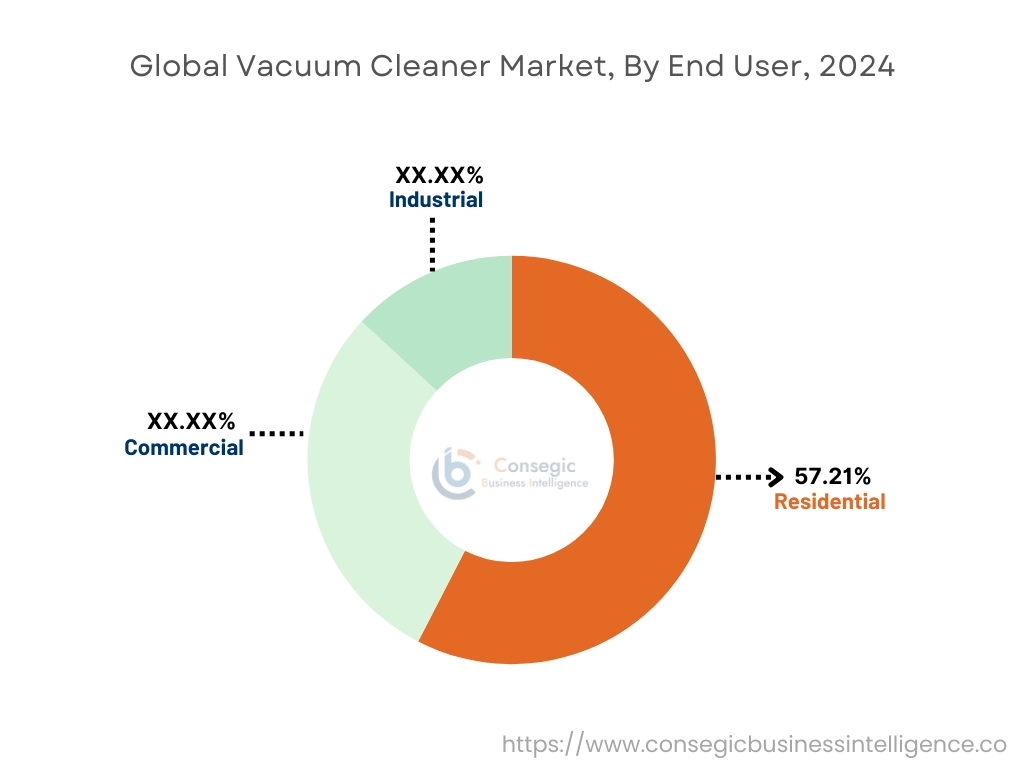
Vacuum Cleaner Market Report Insights :
| Report Attributes | Report Details |
| Study Timeline | 2019-2032 |
| Market Size in 2032 | USD 77.64 Billion |
| CAGR (2025-2032) | 7.6% |
| By Product Type |
|
| By Power Type |
|
| By Distribution Channel |
|
| By End User |
|
| By Region |
|
| Key Players |
|
| North America | U.S. Canada Mexico |
| Europe | U.K. Germany France Spain Italy Russia Benelux Rest of Europe |
| APAC | China South Korea Japan India Australia ASEAN Rest of Asia-Pacific |
| Middle East and Africa | GCC Turkey South Africa Rest of MEA |
| LATAM | Brazil Argentina Chile Rest of LATAM |
| Report Coverage |
|
Regional Analysis:
The regions covered are North America, Europe, Asia Pacific, Middle East and Africa, and Latin America.

Asia Pacific region was valued at USD 16.07 Billion in 2024. Moreover, it is projected to grow by USD 16.94 Billion in 2025 and reach over USD 28.11 Billion by 2032. Out of this, China accounted for the maximum revenue share of 37.7%. The market development for vacuum cleaners is mainly driven by factors, including growing disposable incomes, urbanization, rising awareness of hygiene and cleanliness, technological advancements, and efficient cleaning solutions.
- For instance, In January 2025, LG Electronics acquired 51 percent stake in bear robotics. The aim of the acquisition is to bolster robotics capabilities of LG electronics by advancing AI-driven autonomous service robots capability.
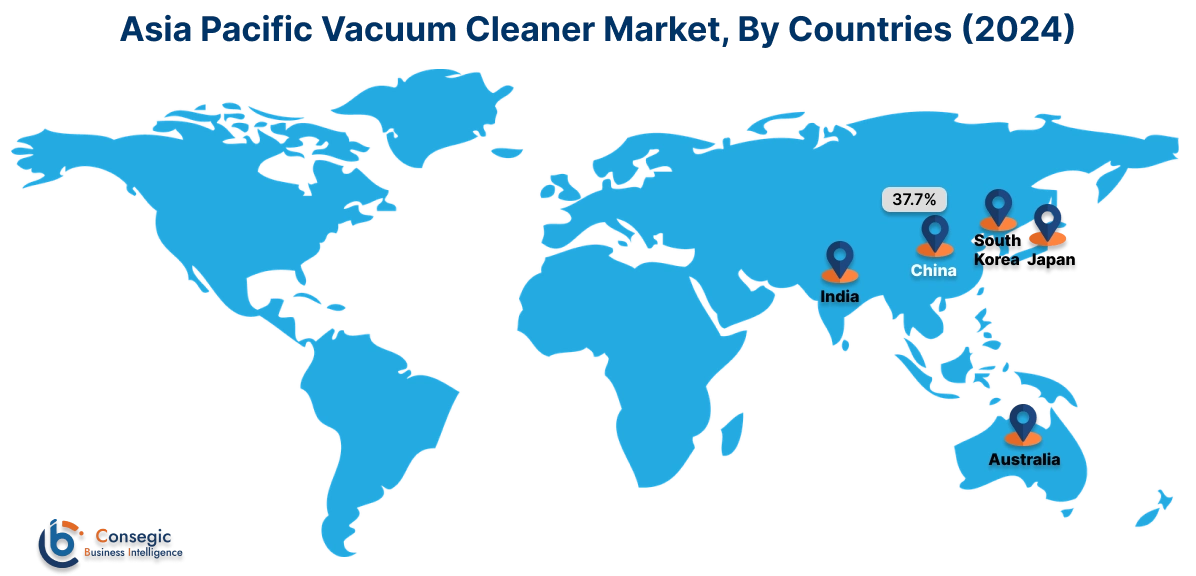
North America is estimated to reach over USD 22.51 Billion by 2032 from a value of USD 13.22 Billion in 2024 and is projected to grow by USD 13.90 Billion in 2025. The North American region's growing need for cordless robotic vacuum cleaners offer lucrative development prospects for the market. Additionally, the presence of premium vacuum cleaning brands in the region drives market development.
- For instance, in April 2024, BISSELL based out in USA launched CrossWave OmniForce, which is a wet and dry vacuum cleaning machine boasts features like power vac and power mop modes, as well as tangle-free technology.
The regional evaluation depicts that the increasing need for energy efficient and eco-friendly vacuum cleaners, high disposable income, and strong focus on hygiene and health in Europe is driving the market progress. Additionally, the primary factor driving the market in the Middle East and African region is smart home and IoT integration with vacuum cleaners and urbanization. Further, the growing e-commerce sales and increasing adoption of affordable and mid-range vacuum cleaners are paving the way for the progress of market in Latin America region.
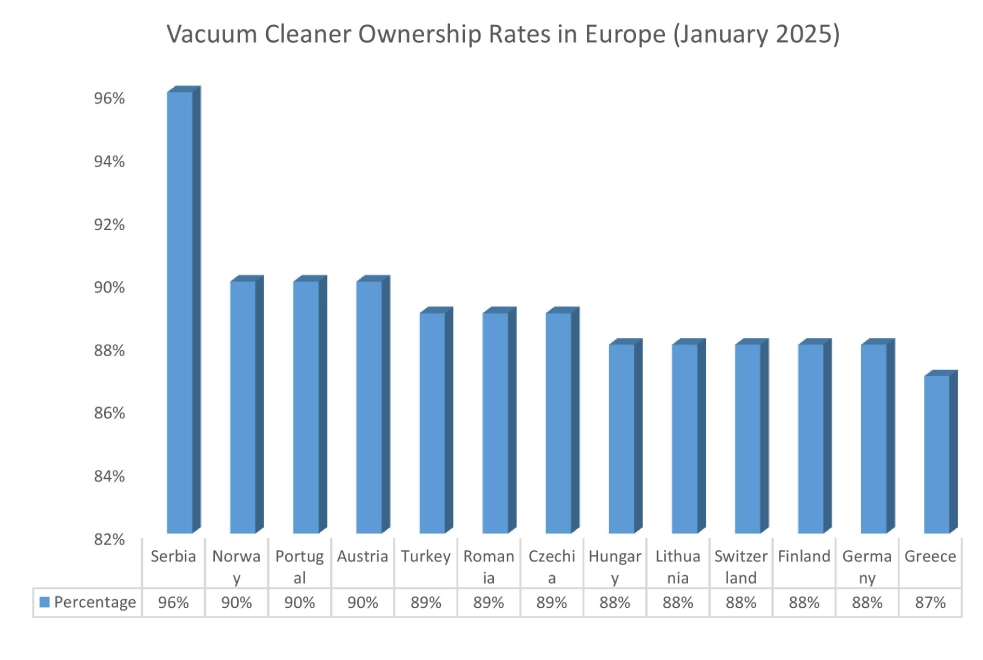
Recent Industry Developments :
- In January 2025, Tineco launched FLOOR ONE S9 Artist Steam, which uses HyperSteam technology to generate superheated steam, dissolving tough grease and stains. Its DualBlock anti-tangle design, 180° lay-flat capability, and triple-sided edge cleaning offer a comprehensive and convenient cleaning experience and its FlashDry self-cleaning system further simplifies maintenance.
- In January 2024, Dreame International showcased its latest smart home cleaning solutions at CES 2024. The company's new lineup includes a variety of innovative products, such as the DreameBot X30 Ultra, DreameBot L10s Pro Ultra, DreameBot L20 Ultra, Dreame H13 Pro Wet and Dry Vacuum, and Dreame Z10 Station Cordless Vacuum Cleaner.
Key Questions Answered in the Report
How big is the vacuum cleaner market? +
The vacuum cleaner market size is estimated to reach over USD 77.64 Billion by 2032 from a value of USD 45.37 Billion in 2024 and is projected to grow by USD 47.73 Billion in 2025, growing at a CAGR of 7.6% from 2025 to 2032.
What specific segmentation details are covered in the vacuum cleaner report? +
The vacuum cleaner report includes specific segmentation details for product type, power type, distribution channel, end user, and regions.
Which is the fastest segment anticipated to impact the market growth? +
In the vacuum cleaner market, commercial is the fastest-growing segment during the forecast period.
Who are the major players in the vacuum cleaner market? +
The key participants in the vacuum cleaner market are LG Electronics (South Korea), Panasonic Corporation (Japan), Techtronic Floor Care Technology Limited (USA), Emerson Electric Co. (USA), Kent (India), ECOVACS (UK), Haier Group Corporation (China), Robert Bosch (UK), Oreck Corporation (USA), Dyson Ltd (Singapore) and Others.
